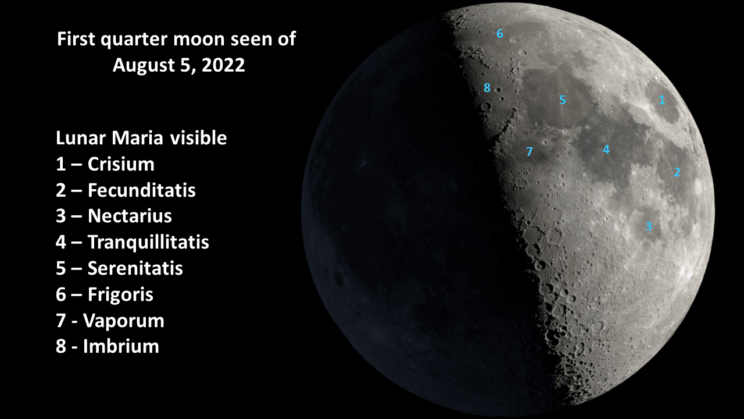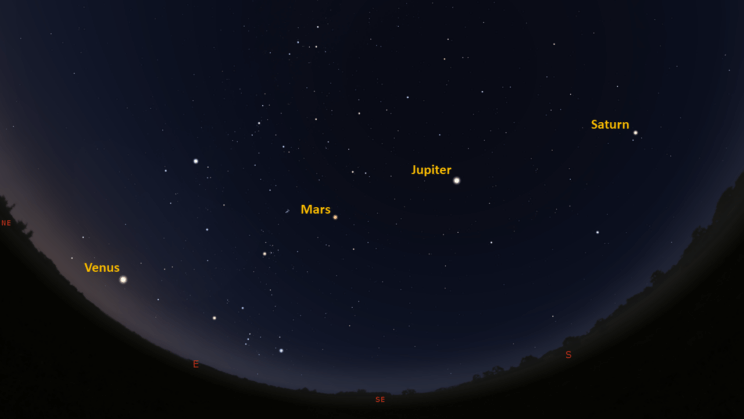This is the Saint Louis Science Center’s NIGHT SKY UPDATE for the week of Friday, July 29, 2022.
Information updated weekly or as needed.
Times given as local St. Louis time which is Central Daylight Time (CDT). For definitions of terminology used in the night sky update, click the highlighted text. If relying on times posted in Universal Time (UT), St. louis is -5 hours when CDT.
Public Telescope Viewings
Public telescope viewings at the McDonnell Planetarium have returned as part of the Saint Louis Science Center’s First Friday event. As we ease back into our telescope nights, they will operate a little different than before. To take part in our telescope viewings you will need to get a ticket for the planetarium show that starts at 7:00 p.m. as part of the First Friday event. Tickets for the First Friday planetarium show are free, but they can only be picked up at the Saint Louis Science Center on the night of the event. After the planetarium show ends you will be able to go outside and look through telescopes weather permitting. We will update this posting if anything changes.
Solar telescopes viewings have also returned and will take place every Sunday from 11:00 a.m. to 3:00 p.m. weather permitting. Solar Sundays will run from May 29, 2022, to September 4, 2022. The return of Solar Sundays is a good opportunity to prepare for the upcoming solar eclipses in 2023 and 2024.
Observing Highlight of the Week

This week the Moon will exhibit waxing crescent phases until August 5, 2022 when it reaches first quarter phase. Look for the Moon in the west after sunset until it reaches first quarter phase. On August 5, 2022 the will be found in the south after sunset. Lunar image credit: NASA, SVS, Ernie Wright.
First quarter moon occurs this week on August 5, 2022. We start with a 1-day old Moon on July 29, 2022, which progresses through the waxing crescent phases. Each night the Moon will appear a bit higher in the west with a little more lunar surface revealed.
During crescent phases, we can enjoy views of the ashen moon. As the Moon approaches first quarter phase on August 5, the ashen moon appearance will begin to disappear as more lunar surface is seen reflecting sunlight. This week is also be a good time to look for the Moon in the daytime. This is safer done closer to the quarter phase as the Moon’s elongation angle will be large enough that there is no danger of accidental views of the Sun. Generally, look high in the west or south depending on the moon phase and time of day. Astronomy software such as Stellarium are great tools to help you find the Moon’s position anytime it is above the horizon.
For those with binoculars or telescopes there are several lunar features to look for this week. As we progress through the waxing crescent phases, lunar maria will make nice binocular targets. As we head to August 5, Mare Crisium, Fecunditatis, Nectarius, Tranquillitatis, Serenitatis, Frigoris. Vaporum and parts of Imbrium will be revealed.
Using telescopes, you can track down the landing sites of Apollo missions 11, 17, 16 and 15. You will not be able to spot the craft left behind, but you can use lunar features to pinpoint the landing sites. Apollo 11, 17 and 15 all have lunar features that makes finding them moderately easy, while Apollo 16 presents a tougher challenge. Also of note, Apollo 16 and 17 celebrate their 50th anniversaries this year. Apollo 16 landed on the Moon on April 20, 1972, in the Descartes Highlands. Apollo 17 landed on the Moon on December 11, 1972, in the Taurus Littrow region. Apollo 17 would be the last time humans walked on the Moon but that will hopefully change in 2025. The Artemis III mission is scheduled to launch in 2025 which will be the first crewed mission to land on the Moon since Apollo 17.
Lastly, with first quarter phase occurring on August 5, 2022, you can expect full moon about a week later on August 11, 2022, at 8:36 p.m. This is unfortunate as a near full moon will impact our view of the Perseid meteor shower which peaks on August 12/13, 2022.
The Sun and Moon

The Moon as seen from the International Space Station, on July 31, 2011.
Credit: NASA
Sunrise is at 6:00 a.m. on Friday, July 29 and sunset is at 8:14 p.m. providing us with a bit over 14 hours of daylight. Even after sunset, the light from the Sun will dimly illuminate our sky for a little under two hours. This period is called twilight, which ends around 10:01 p.m. this week. For those with a sundial, local noon occurs around 1:07 p.m. this week.
| Day | Sunrise | Sunset |
|---|---|---|
| 2022-07-29 | 6:00 a.m. | 8:14 p.m. |
| 2022-07-30 | 6:01 a.m. | 8:13 p.m. |
| 2022-07-31 | 6:02 a.m. | 8:12 p.m. |
| 2022-08-01 | 6:02 a.m. | 8:11 p.m. |
| 2022-08-02 | 6:03 a.m. | 8:10 p.m. |
| 2022-08-03 | 6:04 a.m. | 8:09 p.m. |
| 2022-08-04 | 6:05 a.m. | 8:08 p.m. |
| 2022-08-05 | 6:06 a.m. | 8:07 p.m. |
| 2022-08-06 | 6:07 a.m. | 8:06 p.m. |
Moon
Moonrise for Friday, July 29 occurred at 6:35 a.m. and moonset occurs at 9:17 p.m. Friday, July 29, the Moon will exhibit a waxing crescent phase with 2% of the lunar disk illuminated. First quarter moon occurs on August 5, 2022, at 6:07 a.m.
International Space Station (ISS) Observing

There are numerous passes of ISS visible from St. Louis for the week of July 29. They occur during evening hours. The table below lists the best passes visible from St. Louis this week.
Catch ISS from St. Louis starting Friday, July 29
| Date | Starts | Max. altitude | Ends | |||||||
|---|---|---|---|---|---|---|---|---|---|---|
| Time | Alt. | Az. | Time | Alt. | Az. | Time | Alt. | Az. | ||
| 30 Jul | -3.9 | 21:42:05 | 10 | NW | 21:45:25 | 88 | NE | 21:46:26 | 42 | SE |
| 31 Jul | -3.2 | 20:53:36 | 10 | NW | 20:56:52 | 49 | NE | 20:59:45 | 12 | ESE |
| 01 Aug | -2.3 | 21:41:58 | 10 | WNW | 21:44:53 | 28 | SW | 21:46:02 | 23 | S |
| 02 Aug | -3 | 20:53:09 | 10 | WNW | 20:56:26 | 54 | SW | 20:59:29 | 11 | SE |
Magnitude (Mag): The Measure of brightness for a celestial object. The lower the value is, the brighter the object will be.
Altitude (Alt): The angle of a celestial object measured upwards from the observer’s horizon.
Azimuth (Az): The direction of a celestial object, measured clockwise from an observer’s location with north being 0°, east being 90°, south being 180° and west being 270°.
For information about ISS flyovers and other visible satellites, visit www.heavens-above.com
Detailed information regarding all unmanned exploration of our universe, missions past, present, and planned, can be found at Jet Propulsion Laboratories:
The Visible Planets

Looking southeast at 5:00 a.m. July 29, 2022. Credit: Stellarium, EG
This week, four naked eye planets are visible. Venus, and Mars are best seen before sunrise in the east and southeast. Jupiter and Saturn are now rising before midnight and will be good targets by 1:00 a.m. in the southeastern and southern sky.
Venus
Venus has started a morning apparition and will be seen in the southeast before sunrise. Venus rises at 4:03 a.m. and should be easy to spot in the southeast by 5:00 a.m. The current morning apparition lasts until the third week of October 2022. Venus reaches superior conjunction on October 22, 2022.
Mars
Mars rises at 12:40 a.m. Start looking for the red planet around 1:40 a.m. as it clears trees and buildings. Mars will continue to climb out of the Sun’s glare as it heads towards opposition later this year on December 7, 2022.
Jupiter
Jupiter rises at 10:57 p.m. and should be visible by 12:00 a.m. As the year goes on, Jupiter will rise about 25 minutes earlier than it did the week before. Jupiter will reach opposition on September 26, 2022, so our best views of this giant world will come at the end of summer and through the fall months.
Saturn
This week Saturn will rise around 9:02 p.m. Start looking for Saturn around 10:00 p.m. in the southeastern sky. Saturn will reach opposition on August 14, 2022. As we head to this date, Saturn will rise earlier each day.
James S. McDonnell Planetarium
Night Sky Update: July 29 – August 6, 2022






